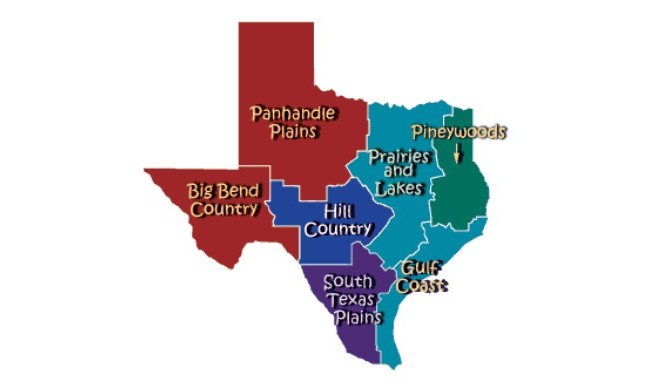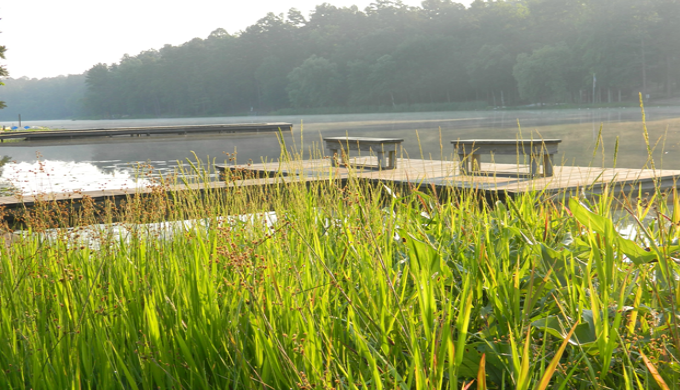Easy is not the first word that comes to mind when someone thinks of traveling the state of Texas. Our great state is so large, it might be difficult to figure out where to begin. But using the same train of thought that you use to approach a complicated or overwhelming project, you can break the overall project down into smaller, more manageable segments. Texas can be divided into seven regions, each with its own distinct geographical features and attractions. These regions are: Big Bend Country, Gulf Coast, Hill Country, Panhandle Plains, Piney Woods, Prairies and Lakes, and South Texas Plains. You can choose one to start with, and work your way through each of them as you find time.
 Texas Parks & Wildlife
Texas Parks & Wildlife
Things to Do
Texas Traveling Made Easy in 7 Regions of Texas
1. Big Bend Country Region

Photo: John Shellington, Facebook/BigBendNPS
The Big Bend region is far west Texas, and it has wide-open spaces with rugged plateaus and desert mountains. The only mountains in Texas are found here. Named after the big bend of the Rio Grand River, there is also a national wildlife refuge and state park with the same name. Big Bend National Park is one of the most well-known national parks in the country. El Paso is the largest city in this region.
There are other, smaller cities and towns in this area, but they are not very close together. Because their locations are so remote, the different towns have each developed their own unique charm, and visitors enjoy exploring places such as Alpine, Del Rio, Presidio, Ft. Stockton, and Marfa. A particularly interesting draw to the town of Marfa is the Marfa Ghost lights, an unusual phenomena where unexplained orbs of light glow in the sky often, and have since the late 1800s. Some of the most popular activities in the Big Bend Region are mountain climbing, hiking, and river rides on the Rio Grande River.
2. Gulf Coast Region

Photo: Judy Peacock
The Gulf Coast region stretches along the Gulf of Mexico for hundreds of miles, from the Mexican border to Louisiana. Near the gulf waters, you will find marshes, barrier islands, prairies, grasslands, and bays. Some of the larger and most well-known cities in the Gulf Coast region are Houston, Galveston, Corpus Christi, and South Padre Island.
There are also a lot of smaller, charming towns to explore. You can find a large variety of things in this region, from modern attractions such as the Galveston Pleasure Pier, Texas State Aquarium, and Schlitterbahn Water Park, to well-populated beaches and isolated stretches of seashore. Visitors to Texas love the Gulf Coast Region, and they come here to attend many types of annual festivals as well as to enjoy fishing, windsurfing, birdwatching, swimming, sailing, and all sorts of sand and surf activities along the shoreline.
3. Hill Country Region

Photo: Judy Peacock
The Texas Hill Country is located pretty much in the center of the state. Its terrain is hilly, with many springs and steep canyons, and also hidden, underground lakes and caves. The largest city in this region is the state capital, Austin.
But there are numerous other smaller cities and towns that populate this area, each having their own beauty and charm, just waiting to be discovered. Some of the more popular tourist locations are New Braunfels, Fredericksburg, Wimberley, and Gruene. The Hill Country has beautiful natural attractions, like Enchanted Rock, the Guadalupe River, and Natural Bridge Caverns, as well as great shops, restaurants, and wineries throughout the entire region. Along with countless annual festivals and events, there are so many things to do here in this region, a visitor may want to set up a base, and plan a lot of day trips to take in as many of the remarkable opportunities as they can.
4. Panhandle Plains Region

Photo: OneMansBlog.com
The Panhandle Plains area includes the northernmost area of Texas and stretches downward to meet the Big Bend Country, Hill Country, and Prairies and Lakes regions. The region is mostly flat, treeless grassland or plains. The western and eastern parts of this region are divided by deep canyons carved by rivers and tributaries that wind their way through the plains. Palo Duro Canyon and Caprock Canyons State Park are in this region. Some of the most well-known cities in this region are Amarillo, Brownwood, Canyon, and Lubbock. From a United States’ traveler’s point of view, the best known thing in the Texas Panhandle is Historic Route 66, which runs through Amarillo. Other unique roadside attractions in this region are the famous Cadillac Ranch, Stonehenge II, and Amarillo’s Big Texas Steakhouse.
5. Piney Woods Region

Photo: David Peacock
The easternmost region of Texas, down the Louisiana border to the Gulf Coast region, is the Piney Woods region. It is primarily a thick forest of pine trees, a woodland, which is part of a larger forest that extends into Louisiana, Arkansas, and Oklahoma. Swamps are common here, particularly in the southern most area of the region which is called the “Big Thicket.” The only “major” cities in the area are Conroe, Huntsville, and Tyler, but there are numerous small towns with lots of interesting history and charm, like Jefferson, Palestine and Texas’ oldest town, Nacogdoches. There is an 1890s-era steam engine train that runs between Rusk and Palestine, an attraction that draws many a visitor who enjoys the unique vantage point to tour East Texas. And when the region’s numerous beautiful Dogwood trees are in bloom, the train ride is especially popular.
6. Prairies and Lakes Region

The Prairies and Lakes region is in north central and central Texas. It includes the Dallas/Fort Worth Metroplex, College Station, Waco, and countless other large and small cities and towns. The land here is gently rolling to hilly, and as the name implies, has lots of lakes. This is an extremely diverse region where you can go from big city Dallas business, fashion, and museums to Fort Worth Stockyards, shops, and restaurants to small town antiquing or farm life. There are numerous colleges and universities in this region. Also, this area has some very popular state parks, such as Lake Fork, Lake Ray Roberts, and Cedar Hill. It also has famous fishing tournaments, where people come from all over the state of Texas and even other states in hopes of catching the big one. Arlington is in this region, which has numerous tourist attractions such Six Flags Over Texas, Hurricane Harbor, and the home stadiums for the Dallas Cowboys and the Texas Rangers.
7. South Texas Plains Region

Photo: Judy Peacock
The South Texas Plains region runs from the lower edge of the Hill Country and the western edge of the Gulf Coast region down into the subtropical regions along the Rio Grande River called the Lower Rio Grande Valley. Much of the region is dry and covered with grasses and thorny brush. However, the Lower Rio Grand Valley has a unique ecosystem and is home to palm trees, subtropical woodlands and lots of tropical birds. Birdwatchers from around the world come to this region to view the various birds here, including visiting the World Birding Center, found here. The largest city in this region is San Antonio, which is possibly the most popular vacation destination in the state of Texas. San Antonio is home to an endless list of things to see and do – historical landmarks, sporting events, theme parks, shopping, and the beautiful Riverwalk, to name a few. Some of the other cities in this area, all of which have interesting and unique things to do, are Brownsville, Harlingen, Crystal City, McAllen, and Laredo.
References:
“Texas Travel Experience,” gotexas.about.com
Wikipedia

